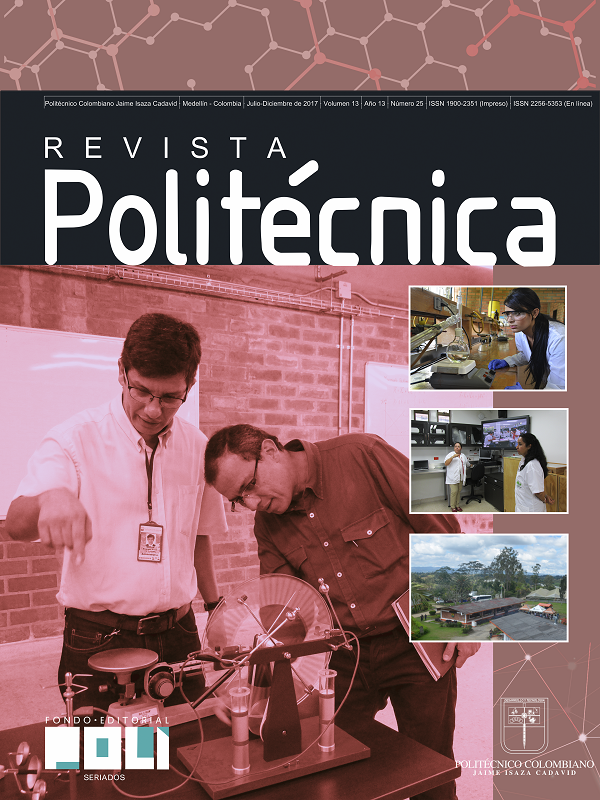Análisis del desempeño de esquemas codificación turbo y convolucional en el enlace de bajada de ITE-advanced
DOI:
https://doi.org/10.33571/rpolitec.v13n25a2Palabras clave:
Codificación convolucional, Codificación turbo, comunicaciones móviles 4G, Desempeño, LTE, MIMO, QAM, Tasa de error de bitResumen
Este artículo presenta un análisis comparativo del desempeño de los codificadores turbo y convolucional aplicables al enlace de bajada de LTE-A, técnología de acceso que se encuentra en auge en la region. Para ello se desarrollaron modelos de simulación a nivel de enlace en Simulink® a partir de recomendaciones de la ETSI que permitieron caracterizar la respuesta de los codificadores en cuanto a tasa de error de bit y throughput encontrando las situaciones particulares donde es preferable usar codificación convolucional sobre la turbocodificación, con el fin de optimizer el uso de recursos computacionales y energéticos de los dispositivos en la red móvil.Métricas de artículo
Resumen: 769 HTML (English): 164 PDF (English): 784 XML (English): 57Métricas PlumX
Citas
I. F. Akyildiz, D. M. Gutierrez-Estevez, and E. C. Reyes, “The evolution to 4G cellular systems: LTE-Advanced,” Phys. Commun., vol. 3, no. 4, pp. 217–244, 2010.
O. G. Jorge, “Estudio de Técnicas de Codificación de Canal en Redes Celulares OFDM,” Cuadreno Red cátedras Telefónica, pp. 4–11, 2012.
ETSI, “TS 136- 212 LTE, Evolved Universal Terrestrial Radio Access (E-UTRA), Multiplexing and channel coding,” 2015.
MathWorks (R), “Convolutional Encoder System object,” 2015. [Online]. Available: https://www.mathworks.com/help/comm/ref/comm.convolutionalencoder-class.html. [Accessed: 10-Jun-2016].
S. Haykin, Communication Systems, 4th ed. México: Wiley India Pvt. Limited, 2006.
A. Thomas, K. Radhakumar, C. Attada, and B. S. Rajan, “Single Uniprior Index Coding With Min – Max Probability of Error Over Fading Channels,” vol. 66, no. 7, pp. 6050–6059, 2017.
G. Durisi, E. G. Str, J. Ostman, J. Li, H. Sahlin, and G. Liva, “Low-latency Ultra-Reliable 5G Communications : Finite-Blocklength Bounds and Coding Schemes,” pp. 1–6, 2017.
C. Anghel, C. Paleologu, and C. Stanciu, “Performances evaluation of CTC turbo decoder for LTE systems,” in 2015 57th International Symposium ELMAR (ELMAR), 2015, pp. 89–92.
P. Gao, “Analysis and realization on turbo equalization based on 64-QAM in OFDM system,” Res. J. Appl. Sci. Eng. Technol., vol. 6, no. 4, pp. 720–728, 2013.
D. Robert, W. W. Library, and L. Riche, “The performance of high-order quadrature amplitude modulation schemes for broadband wireless communication systems,” 2012.
L. K. H. G, K. N. Manjunatha, M. S. Suma, C. K. Raju, P. Cyril, and P. Raj, “Design and Performance analysis of a 3GPP LTE / LTE-Advance turbo decoder using software reference models,” vol. 2, no. 7, pp. 3–6, 2011.
B. Zhang et al., “A 5G Trial of Polar Code,” pp. 7–12, 2016.
E. Migabo and T. Olwal, “A simulation design of LTE communication system under adaptive modulation schemes,” in 2015 International Conference on Emerging Trends in Networks and Computer Communications (ETNCC), 2015, pp. 1–6.
H. Gamage, N. Rajatheva, and M. Latva-aho, “Channel Coding for Enhanced Mobile Broadband Communication in 5G Systems,” pp. 6–11, 2017.
I. Yoo, B. Kim, and I. C. Park, “Reverse Rate Matching for Low-Power LTE-Advanced Turbo Decoders,” IEEE Trans. Circuits Syst. I Regul. Pap., vol. 62, no. 12, pp. 2920–2928, 2015.
GSMA Intelligence, “The Mobile Economy Latin America and the Caribbean 2016,” London, 2017.
MINTIC - Colombia, “Boletín trimestral de las TIC - Cifras primer trimestre 2017,” Bogota, 2017.
O. Ülgen, J. J. Black, B. Johnsonbaugh, and R. Klunge, “Simulation methodology: A practitioner’s perspective,” Dearborn, MI Univ. Michigan, 2006.
S. Schwarz, C. Mehlfuhrer, and M. Rupp, “Low complexity approximate maximum throughput scheduling for LTE,” in 2010 Conference Record of the Forty Fourth Asilomar Conference on Signals, Systems and Computers, 2010, pp. 1563–1569.
S. Gomez Bastar, Metodologia de la investigacion. 2012.
H. Taoka, S. Nagata, K. Takeda, Y. Kakishima, X. She, and K. Kusume, “MIMO and CoMP in LTE-Advanced,” NTT DOCOMO Tech. J., vol. 12, no. 2, pp. 20–28, 2010.
MathWorks (R), “Bernoulli Binary Generator,” 2015. [Online]. Available: https://www.mathworks.com/help/comm/ref/bernoullibinarygenerator.html#fp12158. [Accessed: 10-Jun-2016].
MathWorks (R), “Convolutional Interleaver,” 2015. [Online]. Available: https://www.mathworks.com/help/comm/ref/convolutionalinterleaver.html. [Accessed: 10-Jun-2016].
MathWorks (R), “Adaptive MIMO System with OSTBC,” 2015. [Online]. Available: https://www.mathworks.com/help/comm/examples/adaptive-mimo-system-with-ostbc.html. [Accessed: 10-Jun-2015].
MathWorks (R), “AWGN Channel,” 2015. [Online]. Available: https://www.mathworks.com/help/comm/ref/awgnchannel.html. [Accessed: 10-Jun-2016].
MathWorks (R), “OSTBC Combiner,” 2015. [Online]. Available: https://www.mathworks.com/help/comm/ref/ostbccombiner.html. [Accessed: 10-Jun-2016].


 _
_






















